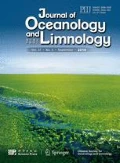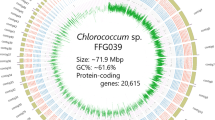Abstract
Marine microalga Nannochl oropsis oceanica LAMB0001 were domesticated (~730 generations, ~two days each) to adapt freshwater BG11 medium. A number of freshwater medium adapted colonyderived strains were obtained. The strains were verified phylogenetically to be N. oceanica LAMB0001 based on the 18S ribosomal RNA gene. Freshwater-medium adapted strain (FA1) grew faster in the BG11 medium prepared with freshwater than wild-type N. oceanica grew in f/2 medium prepared with seawater. We assumed that (1) the expression patterns of the genes that expressed differentially between FA1 and the wild-type N. oceanica exposing to the BG11 medium (WT-F) have been reprogrammed; (2) the physiological processes in which these genes involved have been modified; and (3) a Gene Ontology (GO) term or a KEGG pathway enriched by DEGs between FA1 and WT-F has been up- or down-regulated if it was enriched simultaneously by up- or down-regulated DEGs between FA1 and WT-F, respectively. Under these assumptions, we found that FA1 reprogrammed the expression patterns of a set of genes that involved in cell adhesion, membrane and membrane integrity, material transportation, cell movement, and cellular signaling network. These changes in cellular functions and metabolic pathways indicate that the microalga modified its gene expression pattern in a wide function range and at a high regulation rank in order to adapt to the freshwater medium. It is feasible to domesticate marine microalgae to a freshwater habitat, which may aid to modify their cultivation performances.
Similar content being viewed by others
References
Alverson A J. 2007. Strong purifying selection in the silicon transporters of marine and freshwater diatoms. Limnology and Oceanography, 52 (4): 1 420–1 429.
Anders S, Huber W. 2010. Differential expression analysis for sequence count data. Genome Biology, 11: R106.
Benjamini Y, Yekutieli D. 2001. The control of the false discovery rate in multiple testing under dependency. The Annals of Statistics, 29 (4): 1 165–1 188.
Chen K, Li E C, Li T Y, Xu C, Wang X D, Lin H Z, Qin J G, Chen L Q. 2015. Transcriptome and molecular pathway analysis of the hepatopancreas in the Pacific white shrimp Litopenaeus vannamei under chronic low–salinity stress. PLoS One, 10 (7): e0131503.
Crevillén P, Yang H C, Cui X, Greeff C, Trick M, Qiu Q, Cao X F, Dean C. 2014. Epigenetic reprogramming that prevents transgenerational inheritance of the vernalized state. Nature, 515 (7528): 587–590.
Fawley K P, Fawley M W. 2007. Observations on the diversity and ecology of freshwater Nannochloropsis (Eustigmatophyceae), with descriptions of new taxa. Protist, 158 (3): 325–336.
Galloway R E. 1990. Selective conditions and isolation of mutants in salt–tolerant, lipid–producing microalgae. Journal of Phycology, 26 (4): 752–260.
Gee C W, Niyogi K K. 2017. The carbonic anhydrase CAH1 is an essential component of the carbon–concentrating mechanism in Nannochloropsis oceanica. Proceedings of the National Academy of Sciences of the United States of America, 114 (17): 4 537–4 542.
Guillard R R L, Ryther J H. 1962. Studies of marine planktonic diatoms: I. Cyclotella nana Hustedt, and Detonula confervace a (Cleve) gran. Canadian Journal of Microbiology, 8 (2): 229–239.
Guillard R R L. 1975. Culture of phytoplankton for feeding marine invertebrates. In: Smith W L, Chanley M H eds. Culture of Marine Invertebrate Animals. Plenum Press, New York. p.29–60.
Huang W C, Hu H H. 2013. Study on the salinity tolerance and oil accumulation in Nannochloropsis. Acta Hydrobiologica Sinica, 37 (2): 383–387. (in Chinese)
Ji H T, Pardo J M, Batelli G, Van Oosten M J, Bressan R A, Li X. 2013. The Salt Overly Sensitive (SOS) pathway: established and emerging roles. Mol ecular Plant, 6 (2): 275–286.
Kilian O, Benemann C S E, Niyogi K K, Vick B. 2011. Highefficiency homologous recombination in the oil–producing alga Nannochloropsis sp. Proceedings of the National Academy of Sciences of the United States of America, 108 (52): 21 265–21 269.
Kim D, Langmead B, Salzberg S L. 2015. HISAT: a fast spliced aligner with low memory requirements. Nature Methods, 12 (4): 357–360.
Kouzarides T. 2007. Chromatin modifications and their function. Cell, 128 (4): 693–705.
Larkin M A, Blackshields G, Brown N P, Chenna R, McGettigan P A, McWilliam H, Valentin F, Wallace I M, Wilm A, Lopez R, Thompson J D, Gibson T J, Higgins D G. 2007. Clustal W and Clustal X version 2.0. Bioinformatics, 23 (21): 2 947–2 948.
Liang C W, Cao S N, Zhang X W, Zhu B H, Su Z L, Xu D, Guang X Y, Ye N H. 2013. De novo sequencing and global transcriptome analysis of Nannochloropsis sp. (Eustigmatophyceae) following nitrogen starvation. BioEnergy Research, 6 (2): 494–505.
Liu S K, Wang X L, Sun F Y, Zhang J R, Feng J B, Liu H, Rajendran K V, Sun L Y, Zhang Y, Jiang Y L, Peatman E, Kaltenboeck L, Kucuktas H, Liu Z J. 2013. RNA–Seq reveals expression signatures of genes involved in oxygen transport, protein synthesis, folding, and degradation in response to heat stress in catfish. Physiological Genomics, 45 (12): 462–476.
Lohbeck K T, Riebesell U, Reusch T B H. 2014. Gene expression changes in the coccolithophore Emiliania huxleyi after 500 generations of selection to ocean acidification. Proceedings of the Royal Society B: Biological Sciences, 281 (1786): 20140003.
Mao X Z, Cai T, Olyarchuk J G, Wei L P. 2005. Automated genome annotation and pathway identification using the KEGG Orthology (KO) as a controlled vocabulary. Bioinformatics, 21 (19): 3 787–3 793.
Marschner H. 1995. Mineral Nutrition of Higher Plants. Academic Preßs, London.
Mastrobuoni G, Irgang S, Pietzke M, Aßmus H E, Wenzel M, Schulze W X, Kempa S. 2012. Proteome dynamics and early salt stress response of the photosynthetic organism Chlamydomonas reinhardtii. BMC Genomics, 13: 215.
Pan K H, Qin J J, Li S, Dai W K, Zhu B H, Jin Y C, Yu W G, Yang G P, Li D F. 2011. Nuclear monoploidy and asexual propagation of Nannochloropsis oceanica (Eustigmatophyceae) as revealed by its genome sequence. Journal of Phycology, 47 (6): 1 425–1 432.
Pedersen S F, Hoffmann E K, Mills J W: 2001. The cytoskeleton and cell volume regulation. Comparative Biochemistry and Physiology Part A: Molecular & Integrative Physiology, 130 (3): 385–399.
Perrineau M M, Zelzion E, Gross J, Price D C, Boyd J, Bhattacharya D. 2014. Evolution of salt tolerance in a laboratory reared population of Chlamydomonas reinhardtii. Environmental Microbiology, 16 (6): 1 755–1 766.
Posada D. 2008. jModelTest: phylogenetic model averaging. Molecular Biology and Evolution, 25 (7): 1 253–1 256.
Ronquist F, Teslenko M, van der Mark P, Ayres D L, Darling A, Höhna S, Larget B, Liu L, Suchard M A, Huelsenbeck J P. 2012. MrBayes 3.2: efficient Bayesian phylogenetic inference and model choice across a large model space. Systematic Biology, 61 (3): 539–542.
Rozema J, Schat H. 2013. Salt tolerance of halophytes, research questions reviewed in the perspective of saline agriculture. Environmental and Experimental Botany, 92: 83–95.
Sawan C, Herceg Z. 2010. Histone modifications and cancer. Advances in Genetics, 70: 57–85.
Stanier R Y, Kunisawa R, Mandel M, Cohen–Bazire G. 1971. Purification and properties of unicellular blue–green algae (order Chroococcales). Bacteriological Reviews, 35 (2): 171–205.
Sudhir P, Murthy S D S. 2004. Effects of salt stress on basic processes of photosynthesis. Photosynthetica, 42 (4): 481–486.
Sunday J M, Calosi P, Dupont S, Munday P L, Stillman J H, Reusch T B H. 2014. Evolution in an acidifying ocean. Trends in Ecology & Evolution, 29 (2): 117–125.
Trievel R C, Beach B M, Dirk L M A, Houtz R L, Hurley J H. 2002. Structure and catalytic mechanism of a SET domain protein methyltransferase. Cell, 111 (1): 91–103.
Vieler A, Wu G X, Tsai C H, Bullard B, Cornish A J, Harvey C, Reca I B, Thornburg C, Achawanantakun R, Buehl C J, Campbell M S, Cavalier D, Childs K L, Clark T J, Deshpande R, Erickson E, Armenia Ferguson A, Handee W, Kong Q, Li XB, Liu B S, Lundback S, Peng C, Roston R L, Sanjaya, Simpson J P, TerBush A, Warakanont J, Zäuner S, Farre E M, Hegg E L, Jiang N, Kuo M H, Lu Y, Niyogi K K, Ohlrogge J, Osteryoung K W, Shachar–Hill Y, Sears B B, Sun YN, Takahashi H, Yandell M, Shiu S H, Benning C. 2012. Genome, functional gene annotation, and nuclear transformation of the heterokont oleaginous alga Nannochloropsis oceanica CCMP1779. PLoS Genet, 8 (11): e1003064.
Wagner G P, Kin K, Lynch V J. 2012. Measurement of mRNA abundance using RNA–seq data: RPKM measure is inconsistent among samples. Theory in Biosciences, 131 (4): 281–285.
Weeks D P. 2011. Homologous recombination in Nannochloropsis: a powerful tool in an industrially relevant alga. Proceedings of the National Academy of Sciences of the United States of America, 108 (52): 20 859–20 860.
Young M D, Wakefield M J, Smyth G K, Oshlack A. 2010. Gene ontology analysis for RNA–seq: Accounting for selection bias. Genome Biology, 11 (2): R14.
Author information
Authors and Affiliations
Corresponding authors
Additional information
Supported by the Fundamental Research Funds for the Central Universities (No. 201762017)
Electronic supplementary material
Rights and permissions
About this article
Cite this article
Guo, L., Liang, S., Zhang, Z. et al. Domestication of marine microalga Nannochloropsis oceanica to freshwater medium and the physiological responses. J. Ocean. Limnol. 37, 1353–1362 (2019). https://doi.org/10.1007/s00343-019-8202-1
Received:
Accepted:
Published:
Issue Date:
DOI: https://doi.org/10.1007/s00343-019-8202-1



